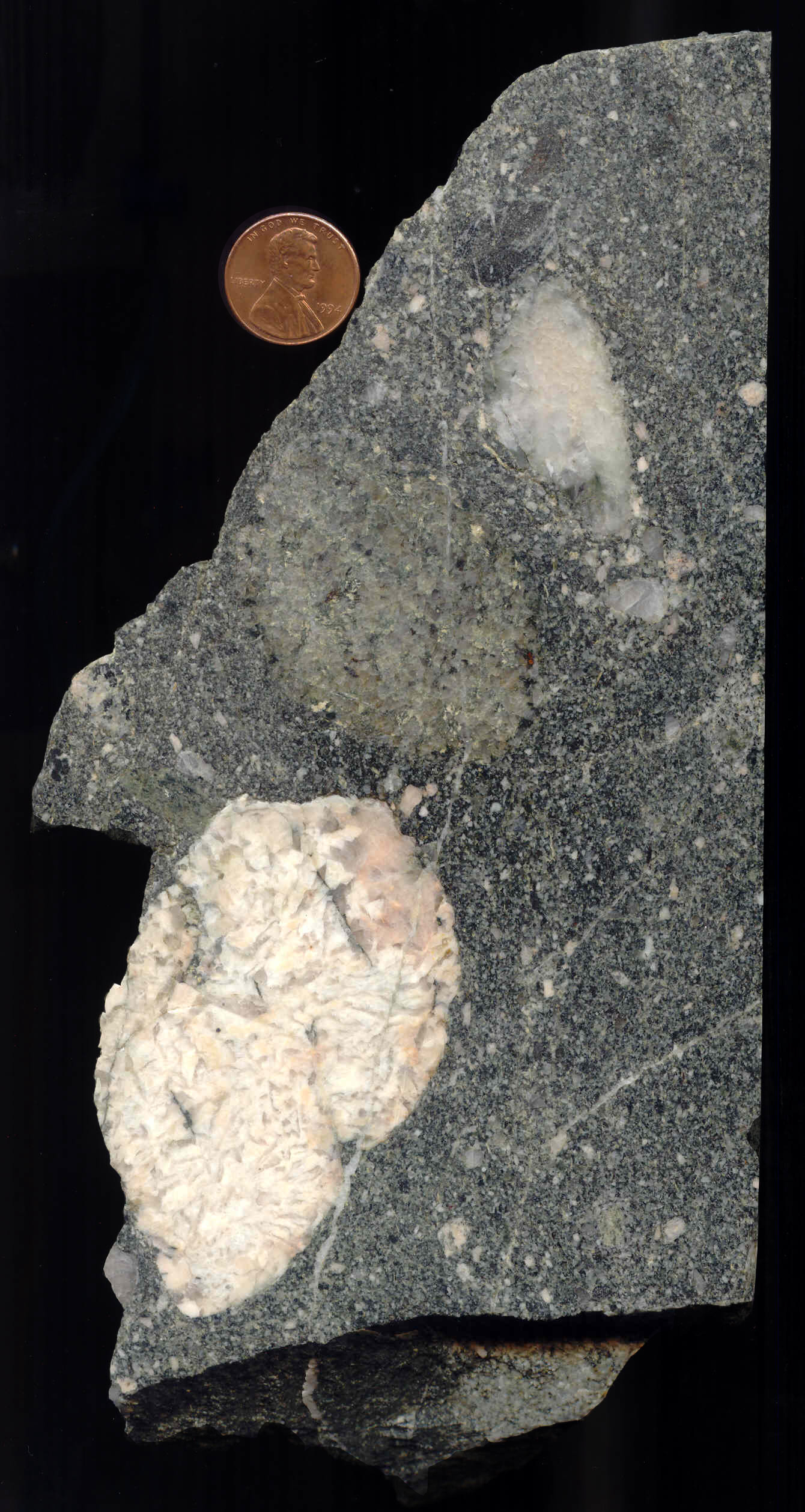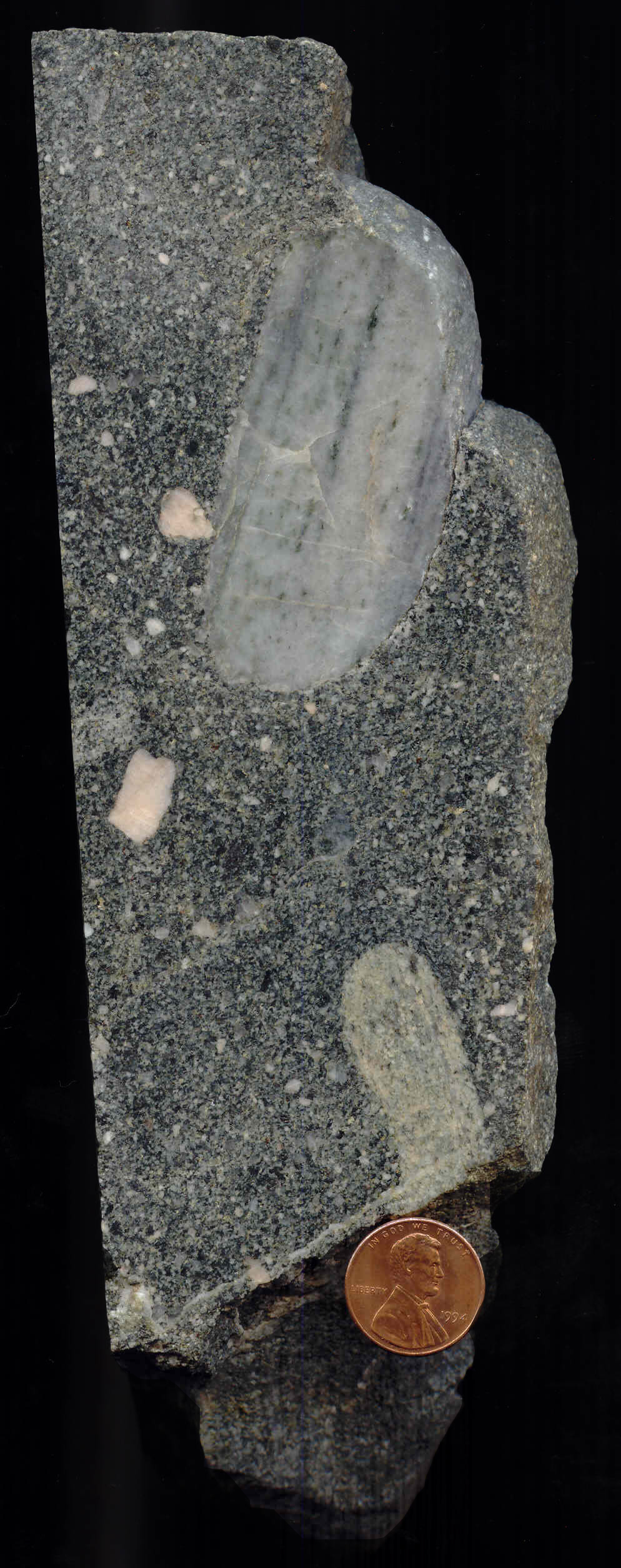12 June 2010
The LaHood Conglomerate
Posted by Callan Bentley
The Belt Supergroup is a series of sedimentary strata laid down in the Belt Sea, an inland sea (like modern Hudson Bay) that existed in the northwestern (by present coordinates) part of ancestral North America during the Mesoproterozoic era of geologic time. Estimates of the absolute age of these rocks range from 1470 to 1400 Ma. Mostly, it’s siltstones (argillites) and limestones, including the multicolored strata so gloriously displayed at Glacier National Park in Montana. But there are some coarser units, too. My favorite is the LaHood Formation, which is a beautiful diamictite well exposed in the canyon of the Jefferson River just east of Cardwell, Montana.
Check out this gorgeous rock (sawn, polished, lacquered, and scanned):
Here it is again, rotated by 90°:
You can click through (twice) for both of these images to get big versions if you want more details. The prominent pinkish clast in the upper scan is a myrmekitic granite, and the prominent grayish clast in the lower scan is marble. These are pieces of the Archean basement complex (Wyoming Terrane), such as we see exposed in the Gallatin Range or the Beartooth Plateau. Note their well-rounded shapes: these cobbles traveled some distance before reaching their depositional location. You can also see pebbles of potassium feldspar, milky quartz, and rock fragments, all set in a dirty sandstone matrix.
Because of the coarse grain size, especially relative to other Belt units, the LaHood conglomerate is interpreted to have been deposited along the southeastern shore of the Belt Sea. Here’s a sketch from my field notebook (from 2008) showing this basic depositional interpretation:
While some of the sediment has been sourced to Montana rocks, I am told that some of it comes from some other landmass, maybe Antarctica or Siberia, indicating their possible paleo-proximity to what is today the northern Rocky Mountains, USA.





 Callan Bentley is Associate Professor of Geology at Piedmont Virginia Community College in Charlottesville, Virginia. He is a Fellow of the Geological Society of America. For his work on this blog, the National Association of Geoscience Teachers recognized him with the James Shea Award. He has also won the Outstanding Faculty Award from the State Council on Higher Education in Virginia, and the Biggs Award for Excellence in Geoscience Teaching from the Geoscience Education Division of the Geological Society of America. In previous years, Callan served as a contributing editor at EARTH magazine, President of the Geological Society of Washington and President the Geo2YC division of NAGT.
Callan Bentley is Associate Professor of Geology at Piedmont Virginia Community College in Charlottesville, Virginia. He is a Fellow of the Geological Society of America. For his work on this blog, the National Association of Geoscience Teachers recognized him with the James Shea Award. He has also won the Outstanding Faculty Award from the State Council on Higher Education in Virginia, and the Biggs Award for Excellence in Geoscience Teaching from the Geoscience Education Division of the Geological Society of America. In previous years, Callan served as a contributing editor at EARTH magazine, President of the Geological Society of Washington and President the Geo2YC division of NAGT.
Limestone from 1400 Ma? Was this limestone of biological origin? What organisms were around that long ago that secreted CaCO3?
It’s not skeletal limestone; more micritic — abiotically precipitated. Belt rocks in Glacier NP have a suite of stromatolite forms: life, though not shell-secreting animal life.
A couple of years ago, zircons were extracted from some of the cobbles found in this canyon and the age of these were found to be nearly identical to that of the nearby Tobacco Root Mountains, indicating that at least some of the sediment was local in origin. The sediment in other portions of the Lahood Formation nearby (a few miles down the road on highway 66, as well as near Manhattan, Montana, and Felix Canyon in the Northern Bridger Range) were dated at approximately 1.86 Ga, which match the ages of some similar units in Siberia, Antarctica, and other regions, leading to a great deal of speculation about the true origins of this material.